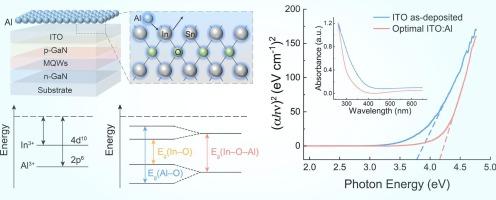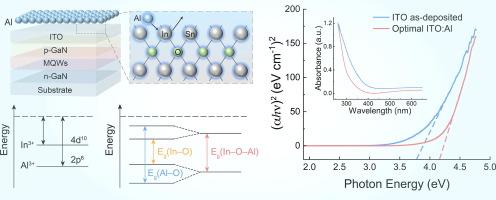调整掺铝铟锡氧化物的带隙以实现高效发光二极管
IF 6.9
2区 材料科学
Q2 CHEMISTRY, PHYSICAL
引用次数: 0
摘要
具有高透光率和低电阻的透明导电电极材料是实现高效光电器件的重要基础。在这里,我们提出了一种涉及Al掺杂和热退火的带隙调谐策略,以提高氧化铟锡(ITO)的光学和电学性能。系统地研究了ITO厚度、Al掺杂层厚度、退火温度、退火时间、O2流速等热退火条件。通过优化退火条件,优化后的ITO:Al表面形貌得到显著改善。在450 nm处透光率提高到98.4% %,片材电阻降低到16.1 Ω/。x射线光电子能谱分析表明,在ITO晶格中Al原子取代了In原子,形成了Al - o键。Al掺杂通过提供足够数量的载流子和增加ITO的能带隙,提高了ITO:Al薄膜的导电性和透射率。最后,我们将最优的ITO:Al用作蓝色发光二极管的p电极,光电性能的改善有效地证明了带隙调谐策略的有效性。本研究为实现高透光率、低电阻的ITO薄膜提供了系统的研究和有效的途径。本文章由计算机程序翻译,如有差异,请以英文原文为准。


Bandgap tuning of aluminum-doped indium tin oxide for efficient light-emitting diodes
Transparent conductive electrode materials with high transmittance and low resistance are essential cornerstones for realizing high-efficiency optoelectronic devices. Here, we propose a bandgap tuning strategy involving Al doping and thermal annealing to enhance the optical and electrical properties of indium tin oxide (ITO). The ITO thickness, Al doping layer thickness, and the thermal annealing conditions—including annealing temperature, annealing time, and O2 flow rate—are systematically investigated. The surface morphology of the optimal ITO:Al is significantly improved via optimization of the annealing conditions. The transmittance at 450 nm is increased to 98.4 % and the sheet resistance is reduced to 16.1 Ω/□. X-ray photoelectron spectroscopy analysis reveals that Al atoms substitute for In atoms in the ITO lattice, forming Al–O bonds. By providing a sufficient number of charge carriers and increasing the energy bandgap of ITO, Al doping enhances the conductivity and transmittance of the ITO:Al film. Finally, we employ the optimal ITO:Al as the p-electrode in blue light-emitting diodes, and the improvement in the optoelectronic performance effectively demonstrate the validity of the bandgap tuning strategy. This work provides a systematic study and an effective approach for achieving ITO films with high transmittance and low resistance.
求助全文
通过发布文献求助,成功后即可免费获取论文全文。
去求助
来源期刊

Applied Surface Science
工程技术-材料科学:膜
CiteScore
12.50
自引率
7.50%
发文量
3393
审稿时长
67 days
期刊介绍:
Applied Surface Science covers topics contributing to a better understanding of surfaces, interfaces, nanostructures and their applications. The journal is concerned with scientific research on the atomic and molecular level of material properties determined with specific surface analytical techniques and/or computational methods, as well as the processing of such structures.
 求助内容:
求助内容: 应助结果提醒方式:
应助结果提醒方式:


